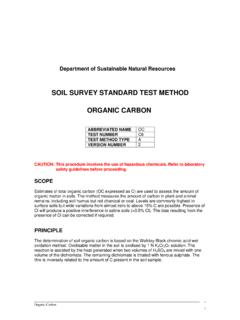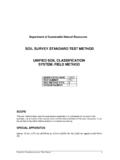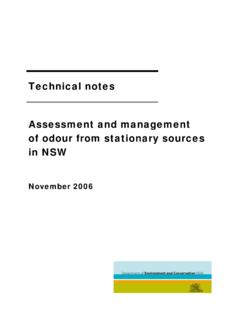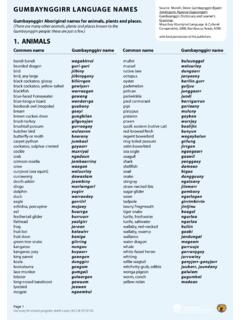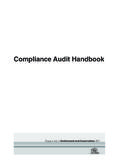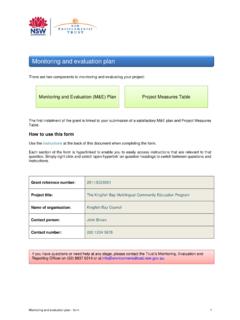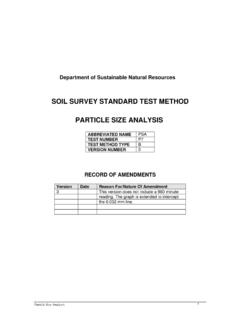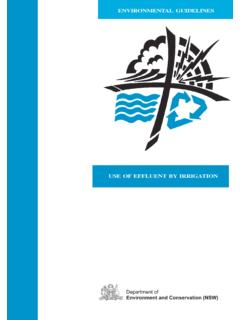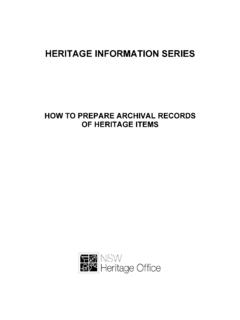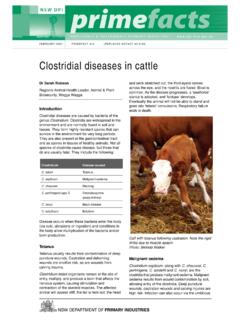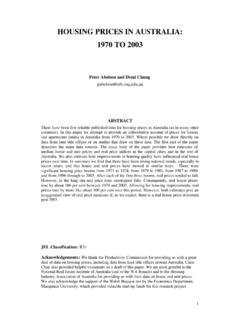Transcription of Emerson Aggregate Test - NSW Environment & …
1 Emerson Aggregate Test1 Department of Sustainable Natural ResourcesSOIL SURVEY STANDARD TEST METHODEMERSON Aggregate TESTABBREVIATED NAMEEATTEST NUMBERP9 TEST METHOD TYPEBVERSION NUMBER2 SCOPEThis test classifies the behaviour of soil aggregates, when immersed, on their coherence inwater. Testing is done only on soils with suitable aggregates. Sands and gravels are usuallyunsuitable for the method describes the procedure for the determination of the Emerson class number ofa soil. Soils are divided into seven classes on the basis of their coherence in water, with onefurther class being distinguished by the presence of calcium-rich APPARATUSE merson Aggregate Test2 250 mL beaker or similar container allowing a minimum depth of 30 mm of water.
2 Spatula. Mixing bowl. Wash bottle containing deionised water. Test Select 3 air-dry aggregates, 5 10 mm Place 75 mL deionised water in the container. Place the 3 aggregates in the containerof water, spaced equally around the side. Do not stir or otherwise Record the time placed in the water. After 2 hours and 20 hours, assess aggregatebehaviour according to the following: Record whether slaking has occurred. (See Figure 1.) If there has been noslaking, record if there has been any swelling of the Aggregate . If the Aggregate has dispersed, note the degree of dispersion. (See Figure 1.)4. If the Aggregate slakes but does not disperse, place about 20 40 g of soil (<2 mm) inthe mixing bowl and add sufficient deionised water to bring the soil to a moisturecontent within the plastic range.
3 Mix for 30 Without using your fingers, form a 5 mm cube of the reworked soil using a spatula ormould. Place the cube of reworked soil into another container of deionised water. Donot stir or otherwise disturb. After 2 hours and 20 hours, rate the degree of dispersion.(See Figure 1.)6. If the reworked Aggregate disperses, note the degree of dispersion. (See Figure 1.)7. If the reworked Aggregate does not disperse, take 5 g of unworked soil and add a few drops of 1M HCl. Effervescence indicates carbonate is If there is no carbonate present, prepare a 1:5 soil:water suspension. Shake for 10minutes. Allow to stand for 5 minutes and note whether the suspension is dispersed If the supernatant of the 1:5 soil:water suspension is clear, check for the presence ofgypsum using 10% barium chloride Aggregate Test3 DETERMINATION OF THE Emerson Aggregate CLASSD etermine the Emerson Aggregate Class Number from Figure 1.
4 Classes 2 and 3 aresubdivided according to the degree of dispersion , PEV 1989, Soils of New South Wales: Their Characterisation, Classification andConservation, Technical Handbook No 1. Soil Conservation Service of New SouthWales. Charman, PEV & Murphy, BW (eds) 1991, Soils: Their Properties and Management: A SoilConservation Handbook for New South Wales, Sydney University Press in associationwith Oxford University Press, Sydney. Emerson , WW 1967, A classification of soil aggregrates based on their coherence in Journal of Soil Research, 5: 47-57. Standards Australia. AS : Methods of testing soils for engineering purposes -Soil classification tests - Dispersion - Determination of Emerson class number of a soil.
5 Emerson Aggregate Test4 DISPERSION SUBCLASSES FOR TYPE 2 AND 3 AGGREGATES1 Slight milkiness2 Obvious milkiness, less than 50% of the Aggregate affected3 Obvious milkiness, greater than 50% of the Aggregate affected4 Total dispersion leaving only sand grains Note: Class 2 (4) is equivalent to Class 1. SLAKINGIn situations where the degree of slaking is considered important, a slaking subclass is allowed:0No change1 Aggregate breaks open but remains intact2 Aggregate breaks down into smaller aggregates3 Aggregate breaks down completely into sand grainsFigure 1. Determining the Emerson Class Number of AggregatesComplete dispersion(Class 1)Some dispersion(Class 2)Dispersion(Class 3)DispersionDP >/= 6(Class 5)Complete flocculationDP <6(Class 6)Prepare 1:5 soil:water 10 minutes, stand 5 and GypsumabsentCarbonate or Gypsumpresent(Class 4)No dispersionRemould at water content equivalent toField Capacity.
6 Immerse in dispersion(Class 7)SlakingSwelling(Class 7)No swelling(Class 8)No slakingImmerse air-dry aggregates in water
